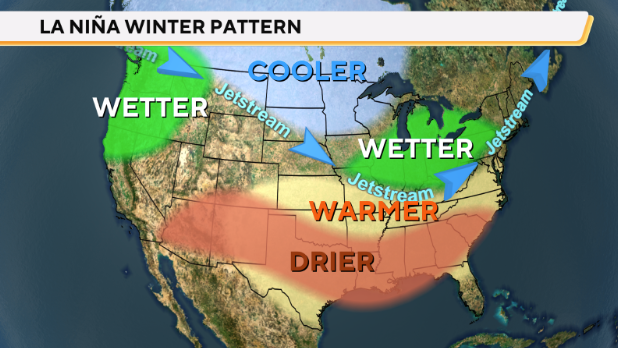Maps show NOAA’s winter outlook

Study finds Americans will move due to extreme weather
The National Oceanic and Atmospheric Administration released its seasonal outlook for the winter months, which predicts the U.S. will slowly transition into a La Niña pattern that could bring wetter-than-average conditions in the North and drier-than-average conditions in the South.
NOAA’s seasonal outlook expects wetter-than-average conditions across the Ohio Valley, the Great Lakes region and the Northwest. Drier-than-average conditions are expected for the Southern Tier of the U.S., specifically from the Four Corners region —which comprises the southwestern corner of Colorado, the southeastern corner of Utah, the northeastern corner of Arizona, and the northwestern corner of New Mexico— and into the Southeast.

The outlook does not project seasonal snowfall accumulations, as snow forecasts are generally not predictable more than a week in advance.
Warmer-than-average temperatures are expected from the southern tier of the U.S. to the eastern Great Lakes, eastern seaboard, New England and northern Alaska. These probabilities are strongest along the Gulf Coast and for most of Texas. Below-average temperatures are most likely in southern Alaska, with below-average temperatures slightly favored from the Pacific Northwest to the northern High Plains.

With the transition to La Niña, drought conditions are expected to improve or end in the Ohio River Valley, the Great Lakes region and portions of the northwestern U.S., including eastern Washington and Oregon and northern and central Idaho.
Above-average precipitation is also favored in northern and western Alaska, the Pacific Northwest and across the northern tier of the U.S. These probabilities are strongest in portions of Ohio, Indiana and Kentucky.
The greatest likelihood for drier-than-average conditions is in states bordering the Gulf of Mexico, as well as in Texas and southern New Mexico. Drought conditions are expected to persist across the Great Plains. Drought is likely to develop or worsen across portions of the Southwest and Gulf Coast.

Much of California, the central Plains states and the Interstate 95 corridor from Boston to Washington, D.C., have equal chances of below-average, near-average or above-average seasonal total precipitation.
NOAA’s seasonal outlooks are designed to help communities prepare for what is likely to come in the months ahead and minimize weather’s impacts on lives and livelihoods. Resources such as drought.gov and climate.gov provide comprehensive tools to better understand and plan for climate-driven hazards.
Nikki Nolan is a meteorologist for CBS News and Stations.







